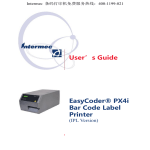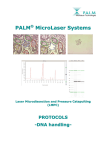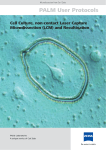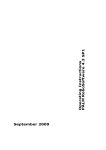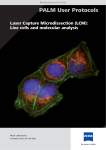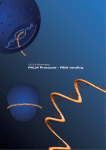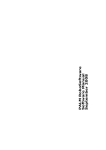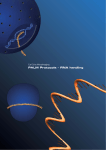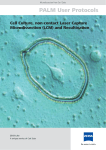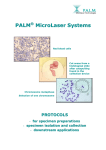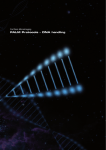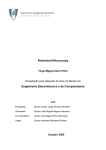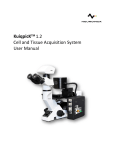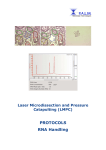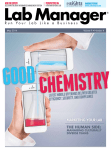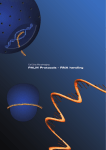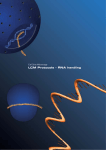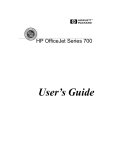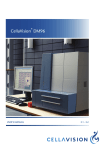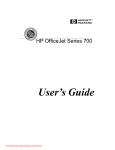Download Application Guide_0808.indd - Plateforme d`imagerie
Transcript
Application Guide PALM Systems Application Guide This document is delivered only to persons who are trained and authorized by Carl Zeiss MicroImaging GmbH. No part of this document may be reproduced or distributed in any form or by any means without the prior written consent of Carl Zeiss MicroImaging GmbH. The information in this document is subject to change without notice. Carl Zeiss MicroImaging GmbH assumes no responsibility for any errors or unclear formulations that may appear. Third Edition August 2008 LMPC is a trademark of Carl Zeiss MicroImaging GmbH. PALM is a registered trademark of Carl Zeiss MicroImaging GmbH. Patent rights: The instruments, instrument components or methods described in this manual are protected by the following patents: - Laser catapult technology (Laser Pressure Catapulting LPCpat) Patents: US 5,998,129, EP 879408 B1 and others. - Three-dimensional laser beam positioning system Patents: US 5,689,109, EP 679325 B1 and others. - Element List Patent: US 6,930,764 - RoboMover: DE 102 54 229.5 - Additional patents pending. Regulatory Notice: PALM Systems are intended for research use only and are not approved for medical applications in the United States and Canada. Published by: Carl Zeiss MicroImaging GmbH Location Munich Kistlerhofstr. 75 81379 München/ Germany Phone: +49 (0) 89 90 9000-800 Fax: +49 (0) 89 90 9000-820 E-mail: [email protected] Web: www.zeiss.de/microdissection © Carl Zeiss MicroImaging GmbH, 2008. All rights reserved. 2 Application Guide PALM Systems 3 1 Introduction 5 2 2.1 2.2 LMPC-Technology (Laser Microdissection and Pressure Catapulting) The Principle of Laser Cutting Lifting of the specimen 6 6 6 3 Modular System 7 4 4.1 Applications Specimen features and preparation techniques 8 8 5 5.1 5.2 5.2.1 5.2.2 5.3 5.3.1 5.3.2 Preparation of specimen Samples on glass slides Samples on membrane slides UV treatment Poly-L-Lysine treatment Mounting sections onto slides Paraffin embedded sections Frozen sections 9 9 10 10 10 10 10 10 6 Histological staining methods 11 7 7.1 7.2 7.3 7.4 7.5 7.6 Enhancement of the image quality by optimizing the microscope Microscope Objectives The Lamp Neutral Density Filters Aperture Diaphragm Camera-Settings 13 13 13 14 14 14 14 Application Guide 8 8.1 8.2 8.3 8.3.1 8.3.2 8.3.3 Tricks to improve the morphology sight of sections Glass covered samples LiquidCover Glass Uncovered Samples Diffusor AdhesiveCaps opaque Ethanol 15 15 15 15 16 16 16 9 9.1 9.2 9.2.1 9.2.2 9.3 9.4 Specimen isolation and collection Cutting with the laser Sample collection Collection into liquid Dry collection Control by ‘CapCheck’ function Collecting the sample extracts 17 17 17 17 17 18 18 10 Laser functions - an overview 19 11 11.1 11.1.1 11.1.2 11.2 11.2.1 11.2.2 11.2.3 11.2.4 11.3 11.3.1 11.3.2 11.3.3 11.3.4 Protocols Working with DNA Preparation of DNA from lifted samples DNA extraction Working with RNA Some special tips for working with RNA Treatment to remove RNases: Preparation of RNA from frozen sections Quality control of RNA Special Preparations Cytospins Blood and tissue smear Isolation of Live Cells Chromosome Preparation 21 21 21 21 22 22 22 23 23 23 23 23 24 24 4 Application Guide PALM Systems 1 Introduction Understanding cellular mechanisms and intercellular communication requires pure samples to study key molecules such as DNA, RNA and proteins. The extraction of homogeneous specimens derived from a morphologically defined origin became one of the most challenging tasks in modern life sciences. Different approaches have been tested to retrieve pure samples from various sources but so far, all of them require mechanical interaction with the specimen in one way or the other. However, direct contact, as for example un-avoidable with needle extraction or application of adhesive transfer membranes, always bears the danger of contamination with neighboring or non-selected material. Carl Zeiss has developed a non-contact LCMtechnology (Laser Capture Microdissection) that made contamination-free sampling possible. Clear defined specimen with precision at the micrometer level opens up new perspectives in scientific research. 5 With this Application Guide we support our customers to find the optimal solution for their special application. You will find tips and tricks for preparing samples, find individual settings for your PALM System and references to information provided by Carl Zeiss, e.g. manuals, product information sheets and protocols. There you will find detailed information for your individual needs and different downstream procedures. Additionally we encourage you to contact our PALM Laboratories with highly qualified specialists. They will assist you in all aspects to obtain the best results. Please ask for up to date protocols, learn on your specific experimental parameters (RentalLab), send us your samples or come to our lab. For questions, remarks or protocol requests please contact: PALM Laboratories E-mail: [email protected] Service Line: +49 (0) 89 90 9000-900 Application Guide 2 LMPC-Technology (Laser Microdissection and Pressure Catapulting) The LMPC technology from Carl Zeiss is a technical innovation of non-contact LCM techniques (Laser Capture Microdissection). It combines the cutting function with the unique technique of lifting the isolated sample contact-free in to a vessel. 2.1 The Principle of Laser Cutting What gives LMPC its decisive edge is the ability to focus light through an objective with a high numerical aperture. Energy can be bundled to a focal point of considerably less than 1 μm. This allows microdissection and micromanipulation down to the subcellular level. Using a 100x oil immersion objective single nuclei, filaments, chromosomes or even chromosomal parts can precisely be isolated. So far, the smallest spot size achieved was 600 nm, when chromosome cutting was performed on a routine metaphase spread. 2.2 Lifting of the specimen The key function of the LMPC-technology is the laser catapult. It was found, that the power of a focused laser not only allows microdissection but is sufficient to transport the selected specimen out of the object plane upwards along the direction of the incident laser light. Thus, sample recovery can be performed without any contamination of non-selected material. Since this process is extremely fast, no heat can be transferred to the sample in this short period. Furthermore, unwanted specimen within larger areas can selectively be eliminated by laser ablation to warrant homogeneity of the subsequently captured samples. So a contamination of surrounding tissue can be avoided. This technology is the breakthrough in modern laser capture methods and allows the entire non-contact sample preparation without risk of contamination in a fast and elegant way. Regardless what source of material is used it offers pure specimen for analysis. Numerous research work was done using either direct lifting or the combination of microdissection and lifting. An innovative approach is to isolate a single live cell out of a heterogeneous cell culture. The viability is not affected and the isolated cell can be recultivated. Principle of LMPC 6 Application Guide PALM Systems 3 Modular System The PALM Family of products is a collection of state-of-the-art tools for precise, non-contact laser based microdissection and micromani-pulation and consists of PALM MicroBeam, PALM MicroTweezers and as a combination of both, PALM CombiSystem. It can be supplemented by different modules that can be adapted to the individual needs: PALM RoboStage II that can be equipped with different target holders for slides, petri-dishes, capillaries and even for work with serial sections. For the positioning of different collecting vessels Carl Zeiss offers: - PALM CapMover for fast positioning of collection vessels with highest precision. - PALM RoboMover for work at higher throughput for complex applications. This unique robotic collection device enables computer driven sampling of lifted specimen from multiple spots into a variety of collecting devices. - The fluorescence attachment expands the microscope to a fluorescence microscope. - All functions can be controlled by the PALM RoboSoftware to facilitate operation and control of PALM Systems. PALM MicroBeam PALM RoboStage II Before starting to work with your PALM System you have to become familiar with the different modules. To learn how to work with the system please refer to the user and software manuals provided. PALM RoboSoftware 7 Application Guide 4 Applications 4.1 Specimen features and preparation techniques PALM MicroBeam with its contact-free LMPC-technology offers a key tool for producing pure, contaminant-free and hence clearly defined specimen material and even live cells for analysis or recultivation. Regardless what source of material is used there are no limits, either in the choice of specimens, preparation or staining techniques. Research activities in Pathology, Cytogenetics, Oncology Sources and preparation: • Histological specimen from glass slides or membrane coated slides • Live cells or cell cultures from a culture dish • Chromosomes and Cytospins • Fluorescence specimens • Cryo preserved or FFPE material • Stained or unstained Unlimited subsequent analyses: • • • • Analyze DNA, RNA and proteins Hybridize to Microarrays Recultivate live cells Select efficiently from heterogeneous cell cultures • Micromanipulate live human, animal or plant cells Wide-ranging research activities: The wide range of source material means high flexibility. With PALM MicroBeam you can: • Retrieve whole tissue regions for oncological studies • Selectively target individual cells such as neurons in tissue for cytological research • Isolate individual particles, fetal cells, sperm cells or chromosomes • Identify and retrieve individual cells from cytospins and smears PALM Systems offer the key tool for solid scientific results with highest flexibility for wide ranging research activities. They can be used in all disciplines of life sciences and can provide purest analytical material for applications like genetic fingerprinting. New discoveries in life sciences with greater efficiency in daily practice – PALM Systems will open up incredible new possibilities from pathology to forensics, from genomic and proteomic analysis to stem cell research. 8 Application Guide PALM Systems 5 Preparation of specimen Workflow When working with low magnifying objectives, including 20x, 40x and 63x long distance objectives, regular 1 mm thick glass slides can be used. Due to the short working distance of the 63x (oil) and 100x (oil) magnifying objectives 0.17 mm thin cover glass slides have to be used. 5.1 Samples on Glass Slides With PALM MicroBeam almost every kind of biological material can be microdissected and lifted directly from standard glass slides, with no intermediate steps. Even archival pathological sections can be used after removing the cover slip and the mounting medium. To facilitate easy lifting additional adhesive substances or “Superfrost + charged slides” should only be applied when absolutely necessary for the adhesion of special material (e.g. brain sections). For these applications higher laser energy for lifting is needed. 5.2 Samples on MembraneSlides MembraneSlides are glass slides covered with a membrane on one side. The membrane is easily cut together with the sample and acts like a stabilizing backbone during lifting. 9 Therefore even large areas are lifted by a single laser pulse without affecting the morphological integrity. This feature is especially important for isolation of single cells, chromosomes as well as live cells or small organisms. Carl Zeiss offers 1 mm and 0.17 mm MembraneSlides. The PEN-membrane (Polyethylene naphthalate) is highly absorptive in the UV-A range, which facilitates laser cutting. It can be used for all routine applications. The PET (Polyethylene terephtalate) covered slides are less sensitive to the cutting laser, that means a higher laser energy is required for cutting. Thus, it is possible to perform laser ablation of unwanted specimen with moderate laser energy without immediate cutting the membrane. After “cleaning” the surrounding a higher laser energy is required to circumcise and lift the selected specimen. We suggest to use PET-membrane covered slides for weakly responding fluorescence samples. Ask also for our nuclease-free MembraneSlides PEN NF. The FrameSlides PET are optimized for immuno-histochemical staining that require microwave treatment. Tissue samples, single cells or chromosomes can be applied on a PETmembrane, which is attached to a metal frame. Application Guide In fluorescence applications even weak signals can be detected due to low signal to noise ratio. 5.2.1 UV treatment To overcome the hydrophobic nature of the membrane it is advisable to irradiate with UV light at 254 nm for 30 minutes. The membrane gets more hydrophilic, therefore the sections (paraffin and cyrosections) will obtain a better adherence. Positive side effects are sterilization and to some extent destruction of potentially contaminating nucleic acids. 5.2.2 Poly-L-Lysine treatment Additional coating with poly-L-Lysine (0.1% w/v) will be only necessary for special materials and should be performed by distributing a drop of the solution on the membrane. Let it air dry at room temperature for 30 minutes. Avoid any leakage underneath the membrane, as this might result in impairment of Laser Pressure Catapulting. 5.3 Mounting sections onto slides Sections are mounted onto MembraneSlides the same way as routinely done with glass slides. For cutting and lifting a coverslip or standard mounting medium must not be applied. Already embedded and covered tissue sections can still be used for laser micromanipulation, after uncovering and removing of the mounting material. 5.3.1 Paraffin embedded sections Mount the sections onto the slide as routinely done. Afterwards let dry at 37 °C up to 56 °C overnight in a drying oven. Deparaffinization Paraffin will reduce the efficiency of laser cutting; sometimes it will make it impossible to cut and lift. If working with unstained sections it is therefore very important not to forget removing the paraffin before laser cutting and laser pressure catapulting. If applying staining procedures deparaffinization is routinely included in any protocols. Minimal Procedure: - Xylene 2 times for 2 minutes - Ethanol 100% 1 minute - Ethanol 96% 1 minute - Ethanol 70% 1 minute - rinse with water With the 1 mm MembraneSlides it is possible to extend the time of Xylene treatment up to 2x15 minutes. Also acetone or isopropanol can be applied. ATTENTION: The thin (0.17 mm) MembraneSlides are not as resistant against organic solvents and should be handled according to the minimal Procedure (see above). 5.3.2 Frozen sections Fixation After mounting the sections there are many possibilities to fix the material. Prepare your sections onto the slide as you do routinely. Let shortly air dry. Dehydrate in 70% ice-cold ethanol for 2-3 minutes (acetone, methanol or other are possible as well depending on the following applications). Subsequently let air dry for some minutes. The slides can now be used at once (even if they are still somewhat wet), stained or deep-frozen at -80 °C. Removing the freeze supporting substance If OCT or another tissue freezing medium is used it is important to get rid of the medium on the slide before Laser Microdissection, because these media will interfere with laser efficiency. Removing of the medium is very easily done by gently washing the slide for about 1 minute in water. If the sections are stained, the supporting substance is removed “automatically” in aqueous staining solutions.Frozen sections should always be allowed to dry for 5 up to 30 minutes at room temperature before use. 10 Application Guide PALM Systems 6 Histological staining methods For constant image recognition and LMPC results, one has to start with a standardized procedure at the very beginning. The first step is the thickness and quality of the cutting at the microtome, which must be maintained at high quality for a good physical sample basis concerning shape and consistence. All subsequent treatment of the sample, e.g., the fixation process up to the staining procedure is also subject of standardization. Staining as the issue of “bringing color to the sample” is a crucial step in visualizing minute details of the sample to recognize and extract. Therefore it is recommended to follow a standard staining procedure, either a protocol issued from Carl Zeiss MicroImaging GmbH or an own, in-house procedure. The reason for the need of a standardized protocol is besides the possibility of insufficient staining or overstaining the reproducibility of the staining procedure to obtain constant results. To our experience almost any standard histological staining (like H&E, Methyl Green, etc.) can be used. In the following you will find some common staining methods that are tested for LMPC. Tissue stained with HE • Hematoxylin/ Eosin (H&E, HE) HE-staining is used routinely in most histological laboratories and does not interfere with DNA or RNA preparation. The nuclei are stained blue, the cytoplasm pink/ red. Procedure: - directly from distilled water - 1-2 minutes Mayer’s Hematoxylin solution (e.g. SIGMA, #MHS-32) - 1 minute rinsing in tap water or blueing solution - 10 seconds up to 3 minutes Eosin Y (e.g. SIGMA, #HT110-2-32) - quick increasing ethanol series - let air-dry at room temperature • Cresyl Violet Because of the easy and short protocol Carl Zeiss recommends the Cresyl Violet staining for DNA, although it was originally developed for RNA. Procedure: - dip slide for 30 seconds in 1% cresyl violet acetate solution (*) - remove excess stain on absorbent surface - dip into 70% EtOH - dip into 100% EtOH - air dry shortly (1-2 minutes) 11 Application Guide Slides can be used immediately or stored at -80 °C before LMPC. To avoid excess condensation of moisture during thawing, the slides should be frozen and rethawed in a tightly sealed container (e.g., 50 ml Falcon-tube). (*) Dissolve solid cresyl violet acetate (e.g., Aldrich cat #86,098-0,or similar) at a concentration of 1% (w/v) in 50% EtOH at room temperature with agitation/ stirring for several hours to overnight. • Nuclear Fast Red The nuclei are stained dark red, the cytoplasm lighter red. Procedure: - directly from distilled water - 5 to 10 minutes Nuclear Fast Red solution (DAKO, #S1963) - rinse in distilled water - let air-dry at room temperature • Methylene Blue The nuclei are stained dark blue. Not recommended for RNA extraction. Procedure: - directly from distilled water - 5-10 minutes Methylene Blue solution (0.05% in water; SIGMA, #31911-2) - rinse in distilled water - let air-dry at room temperature • Toluidine Blue The nuclei are stained dark blue, cytoplasm lighter blue. Procedure: - directly from distilled water - 30 seconds Toluidine Blue solution (0.1% in water; SIGMA, #T-0394) - rinse in distilled water - quick increasing ethanol series - let air-dry at room temperature • Methyl Green The nuclei are stained dark green, the cytoplasm light green. Procedure: - directly from distilled water - 5 minutes Methyl Green solution (DAKO, #S1962) - rinse in distilled water - let air-dry at room temperature 12 Application Guide PALM Systems 7 Enhancement of the image quality by optimizing the microscope PALM Systems are equipped with an inverse Zeiss microscope. This high quality microscope can be used as a normal research microscope with the facility to integrate an image processing software (e.g. AxioVision). For using the LMPC technology you have to consider to define the microscope settings accurately. Working with uncovered specimen which is mandatory for microdissection and harvesting of samples is a challenge for the optical system to obtain an optimal image for identification of details and small objects. There are various possibilities to enhance the image quality that should be adjusted prior to working with the system. 7.1 Microscope Our systems are assembled and preset by our technical service. Nevertheless to tap the full potential condenser, aperture diaphragm and field diaphragm should be adapted due to the Köhler rules before each operation. For instructions in terms of Köhler rules read the instruction manual of the microscope. The long working distance enables the examination through vessels or the inspection in the cap after lifting of the sample. Be aware that the objectives have to be adjusted with the help of the correction ring to the thickness of the used slide (1 mm for standard slides; 0.17 mm for cover glass slides and DuplexDishes). If oil immersion objectives are used, the oil is mandatory. The support for the specimen has to be applicable for the low penetration depth of the optical focus, therefore you must use membranes as support or visualize through a thin glass slide, e.g. a 0.17 mm cover glass slide. Notice: Only use the objectives that are authorized by Carl Zeiss MicroImaging GmbH for laser operations. Do not change or modify any objectives or other hardware or software components. Carl Zeiss is not responsible for any damage resulting from disobeying these points. 7.2 Objectives To be used for microdissection the objectives have to sufficiently transmit UV light to ensure the cutting function of the system. For most applications we recommend long distance LDPlan-Neofluar objectives. This objective group is of highest quality and versatility and appropriate for various staining methods, fluorescence, bright-field, phase-contrast, DIC and others. The objectives are monochromatic and chromatic entirely corrected for the focus level. Another benefit of this system is the high numerical aperture. 13 Zeiss Objectives Application Guide 7.3 The Lamp 7.5 Aperture Diaphragm Most important to obtain comprehensive and objective final results and indispensable for correct identification with automatic image processing is the color temperature of the illumination light source. The color temperature corresponds to the current through the lamp coil, which in turn is represented by the voltage read on the front display of the condenser arm of the microscope. At approximately 10.3 V the system indicates a color temperature of 3200 °K: this should be considered the standard for image visualization. It should become a habit to use the system only at 10.3 V and to decrease the light flux by application of neutral density filters (optional, see 7.4) and camera shutter times only. The aperture diaphragm in the illumination path allows to control the depth of field and is therefore responsible for an excessive “crisp” image or a flaw one, in both cases if set incorrectly. However, the aperture diaphragm must never be used as a diaphragm for attenuation of light, because of the influences it exerts on the illumination behavior of the system. Therefore it is a good start to keep the aperture diaphragm at least 1/2 – 2/3 open (depending on the applied objective) and set the light intensity coarsely by applying neutral density filters. 7.4 Neutral Density Filters The main feature of neutral density filters is an attenuation of the light without change in the light temperature and without any diffusion or stray effects. A good combination may include filters transmitting 3% (0,03) and 12% (0,12) in the inserts in the condenser head. However, the combination of filters accords to your specific sample types and is therefore to be evaluated separately. 7.6 Cameras There are different camera ports available to integrate several digital Zeiss AxioCam camera out of the MR series or a ICc 1 camera (see user manual for further informations). Contact at: [email protected] for detailed information. 14 Application Guide PALM Systems 8 Tricks to improve the morphology sight of sections Next after a correct set illumination path is to prepare the sample itself. The sample is either covered by a glass, LiquidCover Glass or uncovered for LMPC. 8.1 Glass covered samples 8.2 LiquidCover Glass The best image quality can be achieved with embedded and glass covered samples. The light path is exactly guided through the sample and the image to eye or camera is a plain density image representing the colors in their actual density without excess stray. Glass covered samples can´t be used for non-contact LCM. The only use of a glass covered sample during the LMPC process is to employ one sample for reference purpose within the serial section feature. As for LMPC specimen embedding and glass covering cannot be applied, this can result in a poorly visible morphology. LiquidCover Glass completely embeds the tissue and smoothens the rough tissue surface, resulting in enhanced morphology. Additionally the tissue sections are protected against environmental influences e.g. moisture and associated RNAse activity. Cutting and lifting will not be affected. LiquidCover Glass 8.3 Uncovered Samples This is the type of sample that is best for extraction of tissue - the genuine application the MicroBeam instruments are designed for. Unfortunately stray and diffusion on uncovered samples distort the light path. So colors may be distorted and details may become very difficult to detect. 15 Application Guide 8.3.1 Diffusor 8.3.2 AdhesiveCap opaque Adhesive Caps opaque PALM Diffusor A diffuse illumination improves the visualization of the sample and can be performed with the PALM Diffusor. The diffused light reduces the contrast, so that interfering shades are eliminated. For work with image processing software usage of the Diffusor is recommended. The collection devices for PALM RoboMover and CapMover are equipped with diffusors, except the collectors for culture dishes. Alternative to the Diffusor, AdhesiveCap opaque (200 or 500 μl) or AdhesiveStrip 8C opaque (200 μl) can be used due to the similar effect of the opaque filling. These optimized caps are available from Carl Zeiss MicroImaging (see 9.2.2). 8.3.3 Ethanol For a fast monitoring of your section you can use Ethanol to search for an interesting area on your slide. Pipet about 5 μl of ethanol onto this area. You may use 70% or 100% ethanol. When using absolute ethanol a little destaining of the section may happen, but the drying is much quicker. The depiction of the details is improved immediately after contact with ethanol. Now it is possible to select the cells. After the evaporation of ethanol LCM can be performed. 16 Application Guide PALM Systems 9 Specimen isolation and collection 9.1 Cutting with the laser 9.2.1 Collection into liquid Depending on the specimen the laser settings have to be optimized for energy and focus as well as the laser speed. The “factory defaults” may serve as suitable starting points for your experiments, or you can save your individual settings, see your RoboSoftware Manual. For cutting around the specimen the laser energy has to be increased until a small cutting line is performed. With the same laser energy the cutting line will be broader within the plain membrane but thinner within the specimen. Using standard caps or tubes or working with the CapturePlate 96 enables you to choose a filling medium according to the requirements of the applied protocol (e.g. mineral oil or lysis buffer or buffer medium). 9.2 Sample collection Depending on the collection vessel you will have a single cap, AdhesiveStrip 8C or CapturePlate 96 for collection. You will have to position the capturing vessel motorized and software controlled into the line of laser action. We recommend our tailor-made consumables for comfortable research. For details refer to the product information. Please also have a look into the PALM MicroBeam user manual how to work with the collection devices. Filling of the collection vessel: Pipette 3 to 15 μl of buffer (see 11.1.1) into the cap. The isolated cells or cell areas will stick onto the wet inner surface of the cap. 9.2.2 Dry collection For liquid free sampling we recommend AdhesiveCap or AdhesiveStrip 8C. The intention is to allow LMPC without applying any capturing liquid into the caps. They offer quick relocation of the lifted samples in the cap due to instant immobilization. Danger of evaporation and crystal formation during extended specimen harvesting can be eliminated. Liquid free sampling is recommended especially for working with RNA. AdhesiveCap opaque additionally offer an enhanced specimen visualization on stained sections. If you work in a higher throughput mode it will be advisable to use the optimized AdhesiveStrip 8C. It is developed for liquid-free sampling without time consuming manual changing of the caps. Up to 12 AdhesiveStrip 8C can be mounted in one collector. More information on request. If selected ablation of unwanted material is carried out prior to the relevant LMPC procedure, we suggest using a spare cap to avoid crosscontamination. CapturePlate 96 17 Application Guide Working with glass slides LMPC from glass slides usually results in small tissue fragments, which will tightly adhere to the adhesive filling until lysis. The lifted fragments remain visible in the cap until the extraction procedure is performed. time the lysate is spun down in a benchtop centrifuge (5 minutes, 13400 rcf) and samples can then be stored for later use. For details refer to PALM handling protocols. Working with MembraneSlides LMPC from membrane-mounted tissue sections usually results in morphologically preserved tissue within the cap. Working with culture dishes The cutting and lifting procedure is the same for working with dishes. Basically you will use dishes for isolation and manipulation of live cells. Carl Zeiss MicroImaging has designed special accessories and consumables for isolation and recultivation of live cells, e.g. DuplexDish 35 and 50; MembraneRing 35 and 50 and the LiveCell Collector for working in a totally enclosed surrounding. Ask Carl Zeiss MicroImaging for detailed information. AdhesiveStrip 8C 9.3 Control by ‘CapCheck’ function To control the efficiency of lifting it is possible to look into the collection device (e.g. caps, CapturePlate 96) with the 5x, 10x, LD20X, LD40x and LD63x objectives. Controlled by the software PALM RoboStage is moved automatically in the ‘CapCheck’ position and the isolated cells or tissue areas can be focused inside the cap MembraneSlides 9.4 Collecting the sample extracts After microdissection and lifting, depending on the desired volume, digestion/lysis is either performed “upside down” in the cap or lysis buffer is added to the tube and after closure mixed by inversion. After the required incubation LiveCell Collector in a DuplexDish 50 18 Application Guide PALM Systems 10 Laser functions - an overview Depending on the used tissue, preparation and downstream analysis, there are different possibilities to perform non-contact LCM. (Refer to PALM RoboSoftware manual) Cut Cutting along the predefined line. The laser cuts precisely along the predefined line effecting a clear-cut gap between the selected and nonselected material. Thus pure sample preparation is possible without risk of contamination. JointCut A cutting function where the marked line leaves a small connecting bridge. The entire area can be lifted later by a single laser pulse. LPC Laser Pressure Catapulting: Only LPC dot-marked specimens are lifted. The catapult point can be set manually, to individually catapult samples out of tissues after laser cutting. This function is of special benefit for cytocentrifuged specimen and for isolated cells or single particles like e.g. sperm cells. LineAutoLPC With this new laser function samples on glass slides can be harvested along a defined line. It can be used for structures that are extended like arms of dendrites. LPC-points can be set with defined intervals and are adaptive to the line and freehand function. 19 Application Guide RoboLPC Cutting and lifting are proceeded automatically! Only possible with membrane-mounted specimen. The marked line is closed leaving a small connecting bridge from where the entire area is immediately lifted with one single laser pulse. The size of the connecting bridge can be preselected in the Software. CenterRoboLPC Cutting of a geometric area with automated setting of a lifting point in the center. Close&Cut The enhanced cut function will close any incompletely drawn figure by connecting the end point with the start point by a straight line. AutoLPC The tissue of the selected area is isolated by multiple LPC dots and only possible with specimen mounted on glass slides. The cellular material is captured in fragments. The distance of AutoLPCdots can be preselected in the software. Close&Cut and AutoLPC This function combines ‘Close&Cut’ with ‘AutoLPC’. Prior to AutoLPC the selected area is separated by cutting a closed line. 20 Application Guide PALM Systems 11 Protocols The following protocols are only standard procedures. For further questions and up to date protocols benefit from our years of experience – from laser system related assistance to scientific support and laboratory work. 11.1 Working with DNA 11.1.1 Preparation of DNA from lifted samples For best results we at Carl Zeiss recommend to use frozen sections that are lifted into AdhesiveCaps. For DNA-preparation from paraffin sections we usually use a Proteinase K containing Catapult Buffer. This step is mostly not necessary for frozen sections. Then you can proceed directly to normal DNA extraction procedures (see below). Catapult Buffer: (20 mM Tris, 0.1 mM EDTA, 0.5% Igepal, 1% Proteinase K fresh from Stock) Proteinase K digestion procedures Digest for 2-18 hours at 55 °C followed by a heating step at 90 °C for 10 min to inactivate Proteinase K. At best use a thermal cycler with a heating lid for the standard digestion. Recommendable for AutoLPC and small samples: Lift directly into 20 μl Catapult Buffer containing Proteinase K. Digest upside down in the cap for 2-18 hours at 55 °C followed by a heating step at 90 °C for 10 min to inactivate Proteinase K. If not proceeding immediately, store the samples in the refrigerator at 4 °C. Formula to prepare 10 ml: • 0.05 M EDTA pH 8.0 20 μl • 1 M Tris pH 8.0 200 μl • Igepal CA-630 (SIGMA #I-3021) 50 μl • (Proteinase K Stock: 20 mg/ml) (100 μl) fill up to 10 ml • mol. biol. grade H2O Proteinase K Solution 20 mg/ml (Qiagen GmbH, Hilden, Germany; Catalog #19131) Always prepare a fresh mixture of Catapult Buffer and Proteinase K! Notice: The time necessary for complete digestion depends on the kind and on the number of lifted cells. 11.1.2 DNA extraction After the Proteinase K digest (or directly with frozen tissue without fixation) any suitable DNA extraction procedure can be performed e.g., Qiagen QiaAmp DNA micro kit (Qiagen, #56304), Charge Switch gDNA, Microtissue Kit (#CS 11203), Invotrogen, Germany), Phenol/ Chloroform extraction etc. Even use of the crude lysate directly in PCR may be possible with small samples. Do not forget to inactivate the proteinase K! 21 Application Guide 11.2 Working with RNA 11.2.2 Treatment to remove RNases: 11.2.1 Some special tips for working with RNA Slides: MembraneSlides are shipped without any pretreatment. Working with RNA is more demanding than working with DNA, because of the chemical instability of the RNA and the ubiquitous presence of RNases. For best RNA quality we use frozen sections on MembraneSlides and AdhesiveCaps as collection device. • It makes sense to designate a special area for RNA work only. • Clean benches with 100% ethanol or a special cleaning solution e.g., RNase ZAP (Ambion, #9780) or similar. • Always wear gloves. After putting on gloves, do not touch surfaces or equipment to avoid reintroduction of RNases to decontaminated material. • Use sterile, disposable plastic ware. • Use filtered pipettes tips. • Glassware should be baked at 180 °C for 4 hours. (RNases can maintain activity even after prolonged boiling or autoclaving!) • Purchase reagents that are RNase-free. • All solutions should be prepared with DEPC-(diethylpyrocarbonate) treated H2O. • Treat all used material with DEPC. • For best results use either fresh samples or samples that have been quickly frozen in liquid nitrogen or at -80 °C. (This procedure minimizes degradation of RNA by limiting the activity of endogenous RNases.) All required reagents should be kept on ice. • Store RNA, aliquoted in ethanol or RNA buffer, at -80 °C. Most RNA is relatively stable at this temperature. Store prepared slides also at -80 °C. • RNA is not stable at elevated temperatures, there fore avoid high temperatures (>65 °C) since these affect the integrity of RNA. • To ensure RNase-free MembraneSlides, heat MembraneSlides at 180°C for 4 hours to completely inactivate RNases. • An alternative for decontamination of slides is the treatment with RNase ZAP (AMBION, #9780). First dip the slides for a few seconds into pure RNase ZAP, followed by two separate washings in Diethyl pyrocarbonate (DEPC)- treated distilled water and drying at 37 °C for 30 minutes up to 2 hours. • MembraneSlides NF (nuclease free) are certified to be free of DNase, RNase and human DNA. Using these slide treatments to remove nucleases is not necessary. • Treatments of glass slides to remove RNases are identic with the procedure for MembraneSlides. Tubes: In case you don’t like to work with tubes from Zeiss use commercially available RNase free plasticware (e.g. ABgene #AB-0350; 0.5 ml tubes). If only not RNase free tubes are available use the following procedure to remove RNases: Add 0.1 ml DEPC to 100 ml of double distilled water to get a 0.1% DEPC solution (DEPC: e.g. ROTH #K028.1) 1. Stir for 5-6 h at room temperature to dissolve the DEPC 2. Soak the reaction tubes into the DEPC solution, take care that the tubes are completely covered with liquid (not blistered!) and incubate overnight at room temperature 3. Autoclave the tubes together with the solution for 20 minutes at 121°C to inactivate the DEPC 4. Discard the liquid carefully and thoroughly. Dry the tubes at 50°C-80°C. 5. Use the tubes as usual Note: DEPC is toxic and should be used under a hood!!! 22 Application Guide PALM Systems 11.2.3 Preparation of RNA from frozen sections 23 11.3 Special Preparations 11.3.1 Cytospins For capturing microdissected samples from frozen sections we recommended AdhesiveCaps. The RNeasy® Micro Kit (QIAGEN, #74004) in our hands results in a good yield of RNA. But in contrast to most other laser microdissection companies you can go on straight forward with RNA extraction by using your extraction procedure of choice. After LMPC adjust the sample volume to 350 μl with lysis buffer (QIAGEN, RLT buffer) and incubate upside down for 30 minutes. Vortex the digestion mix thoroughly. Then the lysate is spun down in a bench top centrifuge (5 minutes, 13400 rcf); and samples can then be stored for later use at -80°C. NOTE: If using paraffin embedded (FFPE) sections for lifting, please use a buffer containing Proteinase K like mentioned in the DNA protocol (see 11.1.1). For tips working with FFPE sections ask for the special PALM RNA protocol. Cytospins can be prepared on glass slides or on membrane slides. After centrifugation with a cytocentrifuge let the cells air-dry over night. Then fix for 5 minutes in 100% methanol. Allow the cytospins to dry at room temperature before staining. 11.2.4 Quality control of RNA 11.3.2 Blood and tissue smear It is difficult to estimate the amount of RNA that is to be expected after extraction since many factors like species, cell/ tissue-type, degradation, fixation, staining, fragmentation, extraction procedure and others will influence the outcome. The most common method used for assessing the integrity of total RNA is to run the RNA sample on an agarose gel (refer to PALM Protocol, RNA Handling). Distribute a drop of (peripheral) blood or material of a swab smear over the slide. Let smears shortly air-dry and fix them for 2 up to 5 minutes in 70% ethanol. Cytospin Application Guide 11.3.3 Isolation of Live Cells Live cells under PlasDIC view LMPC allows non contact collection and recultivation of isolated living specimen without affection of cell viability. Facilitating consumables like DuplexDish and MembraneRing and the accessories LiveCell Collector and collecting devices enables the absolute contamination free manipulation.Ask for a detailed list of our Zeiss products and protocols for working with live cells. 11.3.4 Chromosome Preparation Chromosomes Preparation of chromosomes is delicate and demands know-how. Please ask for our PALM protocol for chromosomes and metaphases. For questions, remarks or protocol requests please contact: PALM Laboratories E-mail: [email protected] Service Line: +49 (0) 89 90 9000-900 24
























